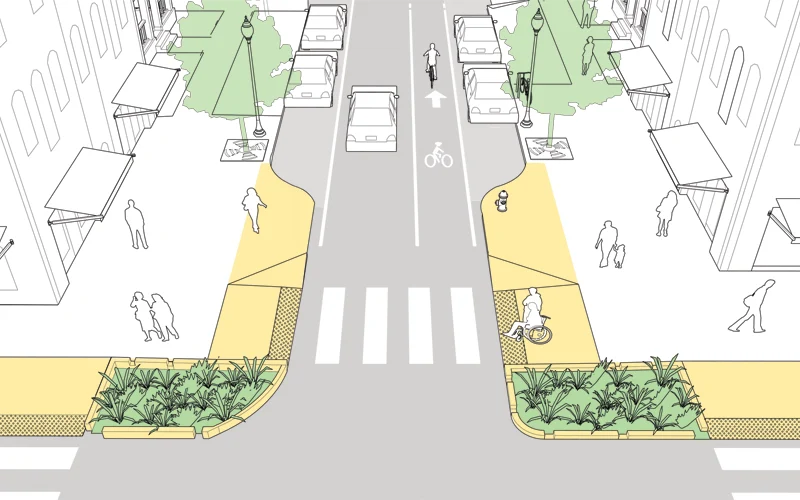
Crafton Tull
Since 1963Enhancing pedestrian access and walkability is a priority for cities everywhere. According to the National Highway Traffic Safety Administration (NHTSA), bicycling and walking activity is on the rise. Unfortunately, this rise in activity has also come with an increase in pedestrian injuries and fatalities.
Increasing pedestrian activity means more people using crosswalks and navigating busy intersections. A publication by the NHTSA reported that about 40 percent of the estimated 5.8 million crashes that occurred in the United States in 2008 were intersection-related crashes.
SOURCE: NACTO
As cities look for ways to improve intersection safety, many are adopting design features such as ladder marking of crosswalks, perpendicular curb ramps, detectable warnings, and medians. Curb extensions, or bulb-outs, are one of the most effective and attractive ways for cities to improve intersection safety and overall walkability. While not appropriate in every situation, curb extensions offer many benefits.
Five key benefits of curb extensions
- Higher Visibility - Curb extensions help improve sight lines for drivers so that pedestrians waiting to cross the intersection are seen more easily. Standard intersections with no curb extensions place foot traffic further away from vehicular traffic, which in some cases can make it difficult for drivers to spot pedestrians.
- Shorter Crossing Distance – Shorter crossing distances improve foot traffic safety and overall walkability. For slow or disabled pedestrians especially, a shorter crosswalk can help ensure a feeling of safety.
- Reduced Vehicle Turn Speeds – Curb extensions shorten the turning radius in intersections, which slows traffic speeds. Curb extensions can still be used in intersections requiring a larger turning radius, although it may require the addition of bike and parking lanes.
- Increased Space – The additional space created by curb extensions, especially longer curb extensions, allow for placement of benches, trash receptacles, light poles, plantings, and other amenities that can help enhance a city’s streetscape.
- Reduced Illegal Parking – Curb extensions make illegal parking at bus stops and in crosswalks virtually impossible.
In places where high foot traffic exists alongside heavy vehicular traffic, curb extensions can help improve safety and may be implemented either as new construction or as retrofits. Downtown areas, entertainment districts, school zones, and large commercial areas are common places where pedestrians and vehicles have frequent interactions. Curb extensions are especially useful in areas with on-street parking, but the design must ensure that parked vehicles do not block the oncoming vehicles’ views of the pedestrians waiting to cross the road. Although curb extensions are generally more expensive than typical crossings, the increased safety for pedestrians and drivers may be well worth the additional cost.

